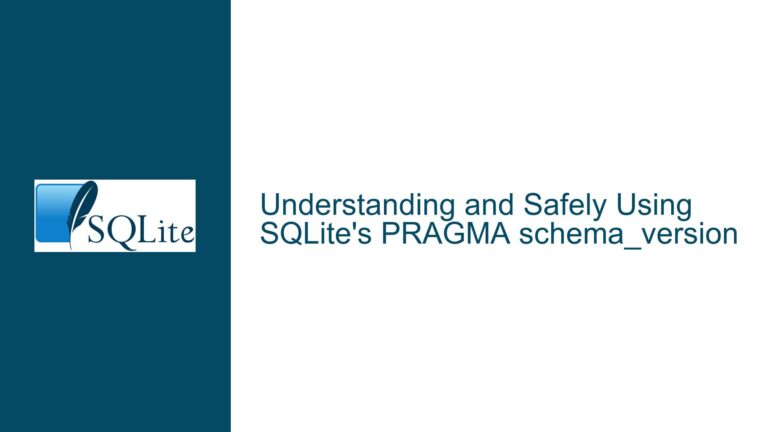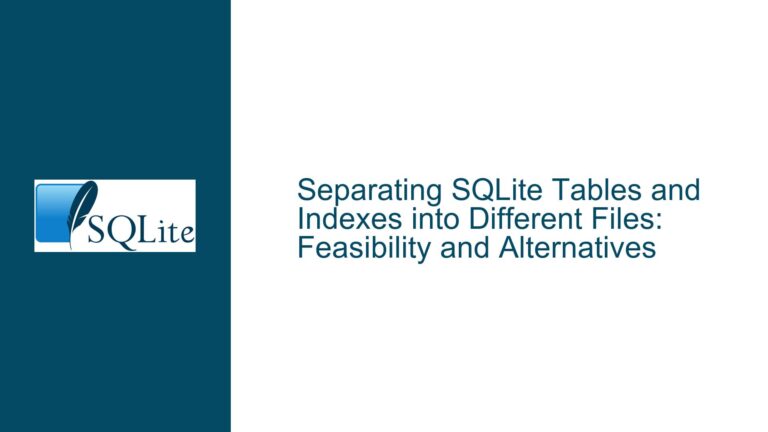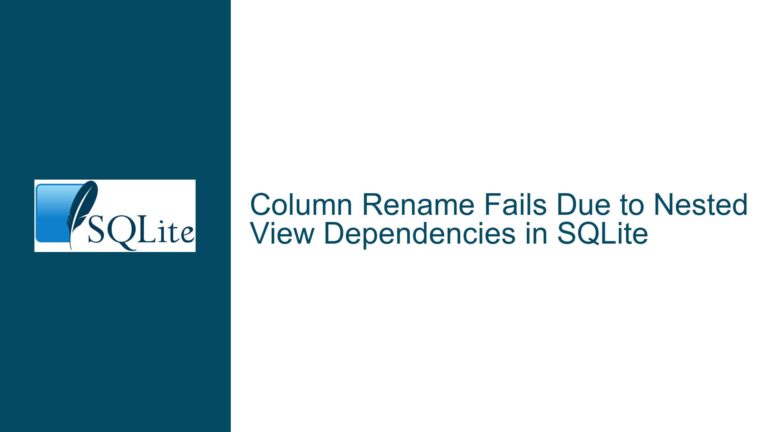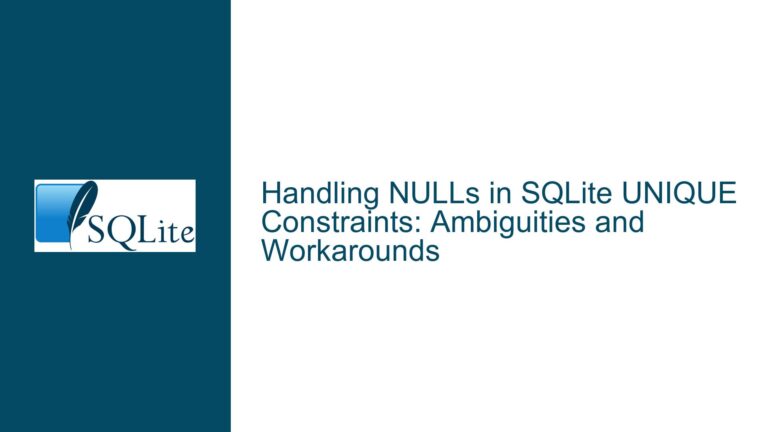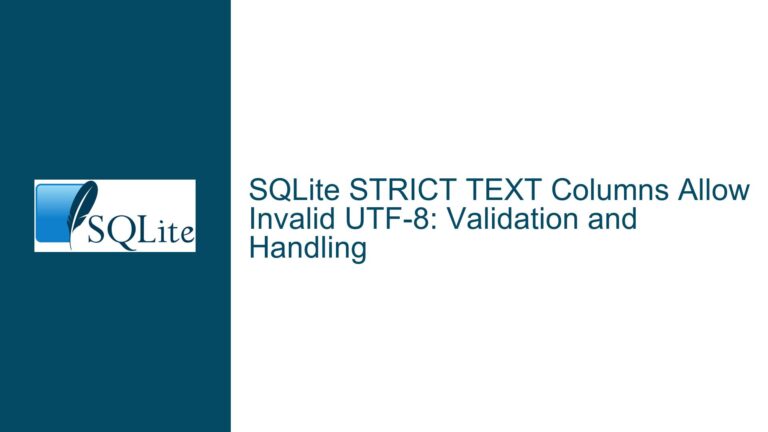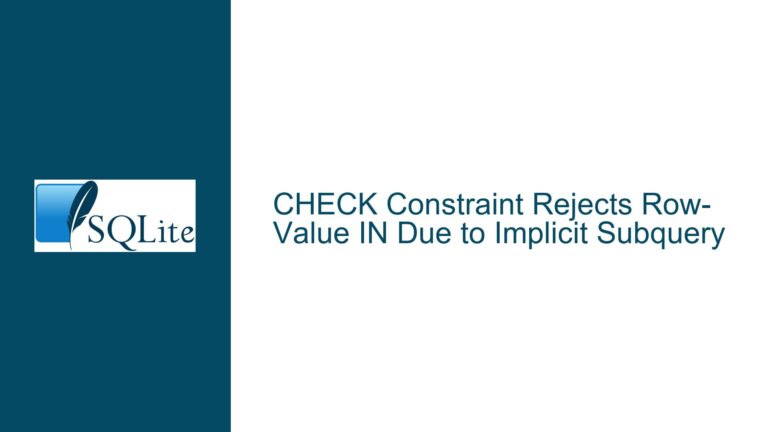Behavioral Difference Between VACUUM and VACUUM INTO in SQLite
Issue Overview: VACUUM INTO Fails to Replicate WAL Journal Mode
The core issue revolves around the behavioral discrepancy between the VACUUM and VACUUM INTO commands in SQLite, specifically regarding the replication of the journal_mode setting. When using VACUUM INTO to create a backup of a database, the resulting backup does not retain the WAL (Write-Ahead Logging) journal mode, even though the original database is configured to use it. This is unexpected because the VACUUM INTO command is documented to behave similarly to VACUUM, with the only difference being that it writes the output to a new file instead of overwriting the original database.
The journal_mode setting is a critical configuration in SQLite that determines how transactions are logged and managed. The WAL mode, in particular, is widely used for its performance benefits, especially in scenarios with high concurrency. When a database is set to WAL mode, this setting is supposed to persist in the database file itself. However, the VACUUM INTO command does not replicate this setting, resulting in the backup database defaulting to the delete journal mode. This behavior undermines the utility of VACUUM INTO as a reliable backup mechanism, as restoring from such a backup would require manually reconfiguring the journal mode.
The issue is reproducible using a simple SQLite CLI script. The script creates a database with WAL journal mode, sets some custom metadata (such as user_version and application_id), and then performs a VACUUM INTO operation to create a backup. Upon inspecting the backup, the journal_mode is found to be delete, while the custom metadata is correctly retained. This inconsistency suggests that the VACUUM INTO command selectively omits certain persistent settings during the backup process.
Possible Causes: Why VACUUM INTO Omits the WAL Journal Mode
The root cause of this issue lies in how the VACUUM INTO command handles the replication of database settings and metadata. While the command is designed to create a structurally identical copy of the original database, it appears to exclude certain persistent settings, such as the journal_mode, from the replication process. This exclusion is likely due to an oversight in the implementation of VACUUM INTO, as the documentation explicitly states that the command should behave similarly to VACUUM, except for the destination of the output.
One possible explanation is that the VACUUM INTO command does not account for the persistence of the WAL journal mode. In SQLite, the journal_mode setting is stored in the database file header, and once set to WAL, it is intended to remain persistent across sessions. However, the VACUUM INTO command may not be reading or replicating this header information correctly, leading to the default delete mode being applied to the backup.
Another potential cause is that the VACUUM INTO command treats the journal_mode as a runtime setting rather than a persistent configuration. Runtime settings are typically not preserved across database copies or backups, as they are considered session-specific. If the VACUUM INTO command mistakenly categorizes the journal_mode as a runtime setting, it would explain why the WAL mode is not replicated in the backup.
Additionally, the issue may stem from the way VACUUM INTO handles the creation of the new database file. When a new database file is created, SQLite initializes it with default settings, including the delete journal mode. If the VACUUM INTO command does not explicitly set the journal_mode of the new file to match the original, the backup will inherit the default settings, resulting in the observed discrepancy.
Troubleshooting Steps, Solutions & Fixes: Addressing the VACUUM INTO Journal Mode Issue
To address the issue of VACUUM INTO failing to replicate the WAL journal mode, several steps can be taken, ranging from temporary workarounds to long-term solutions. These steps are designed to help users mitigate the issue while awaiting potential fixes or updates from the SQLite development team.
Step 1: Verify the Journal Mode After VACUUM INTO
The first step in troubleshooting this issue is to verify the journal_mode of the backup database after performing a VACUUM INTO operation. This can be done using the PRAGMA journal_mode; command, as demonstrated in the reproduction script. By confirming that the backup database is indeed using the delete journal mode, users can rule out any potential misconfigurations or errors in their testing environment.
Step 2: Manually Set the Journal Mode After VACUUM INTO
As a temporary workaround, users can manually set the journal_mode of the backup database to WAL after performing the VACUUM INTO operation. This can be achieved by executing the following command on the backup database:
PRAGMA journal_mode=WAL;
While this workaround ensures that the backup database uses the desired journal mode, it requires additional manual steps and may not be practical in automated backup workflows.
Step 3: Use Alternative Backup Methods
If the VACUUM INTO command cannot reliably replicate the journal_mode, users may consider using alternative methods for creating database backups. One such method is the .backup command available in the SQLite CLI tool. The .backup command creates a byte-for-byte copy of the database, including all settings and metadata. For example:
.open test1.db3
.backup test2.db3
This method ensures that the backup database retains all configurations, including the journal_mode.
Step 4: Modify the VACUUM INTO Implementation
For users with access to the SQLite source code or the ability to compile custom builds, modifying the VACUUM INTO implementation to explicitly replicate the journal_mode setting is a potential long-term solution. This would involve updating the command to read the journal_mode from the original database and apply it to the new database during the backup process. While this solution requires technical expertise, it addresses the root cause of the issue and ensures consistent behavior across all backups.
Step 5: Advocate for Documentation Updates
Given that the current documentation for VACUUM INTO does not explicitly mention the exclusion of the journal_mode setting, users can advocate for updates to the documentation. By clarifying the limitations of the command, the SQLite development team can help users make informed decisions when choosing backup methods. Additionally, updating the documentation to reflect the actual behavior of VACUUM INTO would prevent misunderstandings and ensure that users are aware of the need to manually configure the journal_mode after creating a backup.
Step 6: Monitor SQLite Updates and Patches
Finally, users should monitor updates and patches released by the SQLite development team for any fixes related to the VACUUM INTO command. As the issue has been identified and discussed in the community, it is possible that future versions of SQLite will include enhancements to address this behavior. By staying informed about updates, users can take advantage of any improvements or fixes that are introduced.
In conclusion, the behavioral difference between VACUUM and VACUUM INTO regarding the replication of the WAL journal mode is a significant issue that affects the reliability of database backups. By following the troubleshooting steps and solutions outlined above, users can mitigate the impact of this issue and ensure that their backups retain the desired configurations. Additionally, advocating for documentation updates and monitoring SQLite developments will contribute to long-term improvements in the functionality and usability of the VACUUM INTO command.

